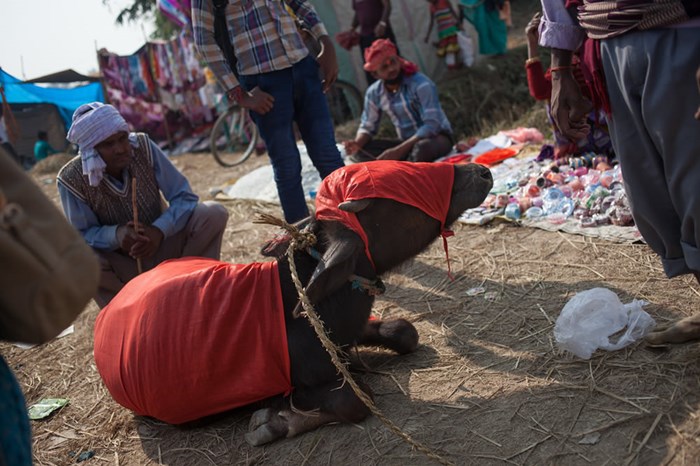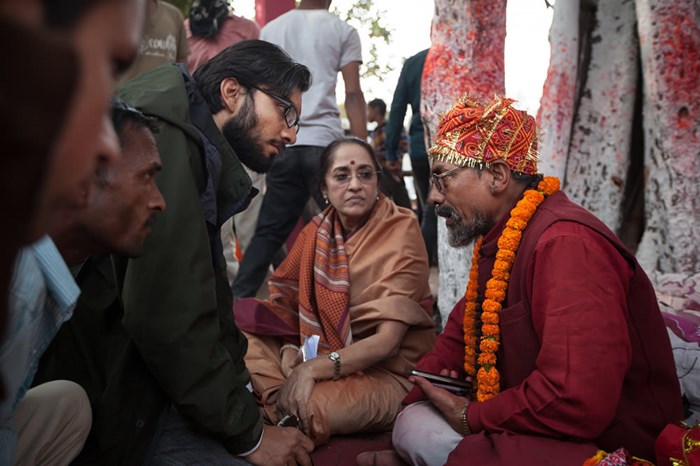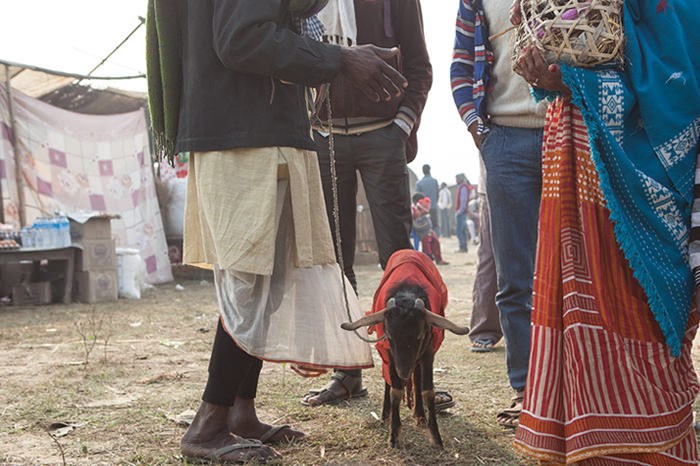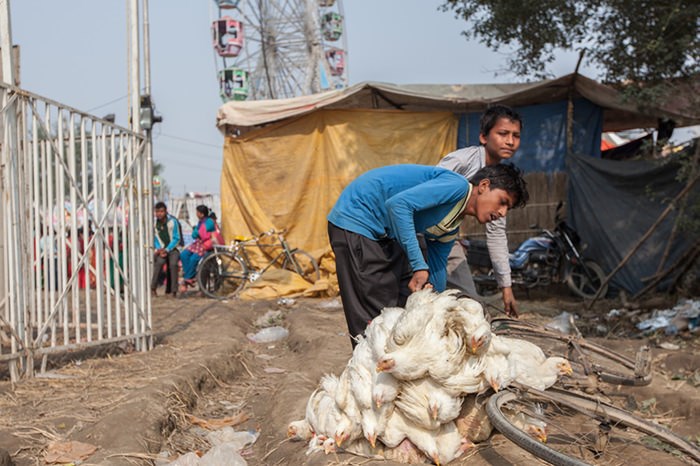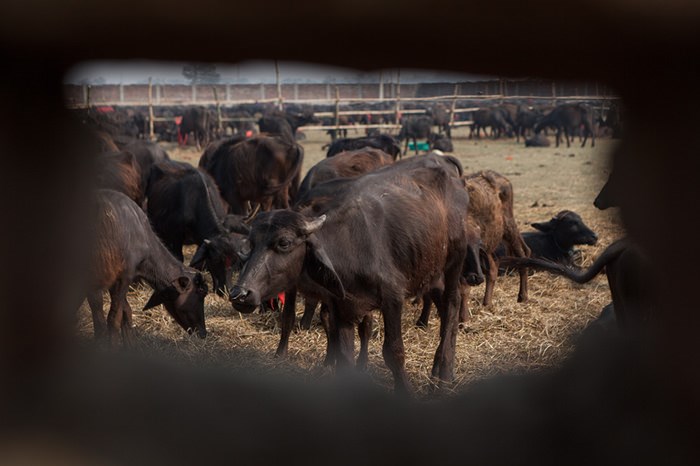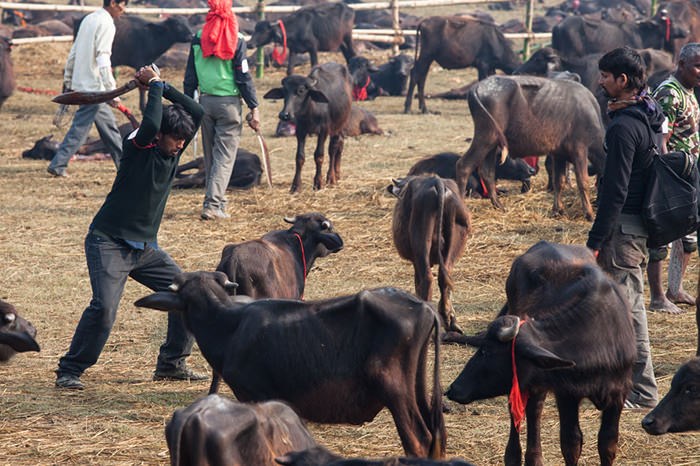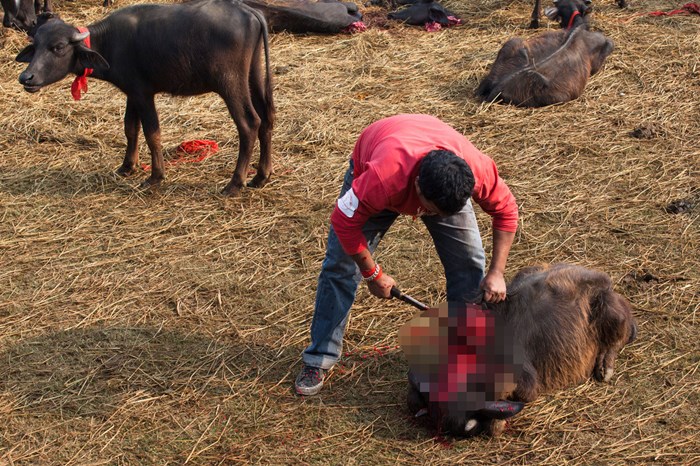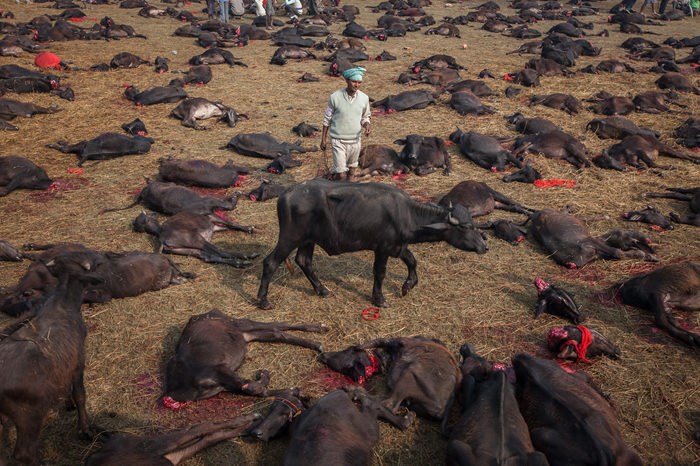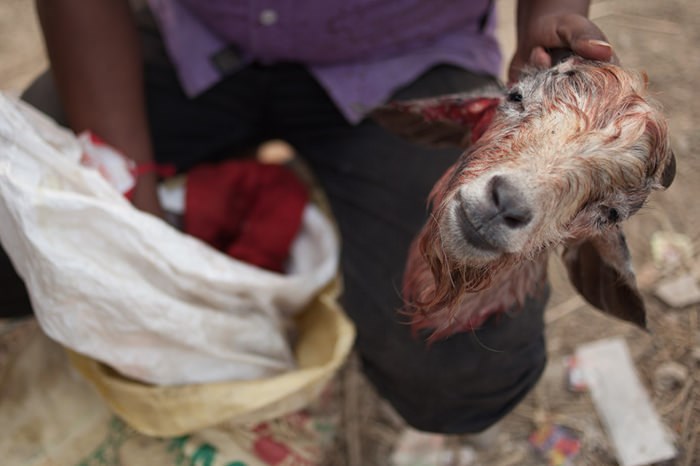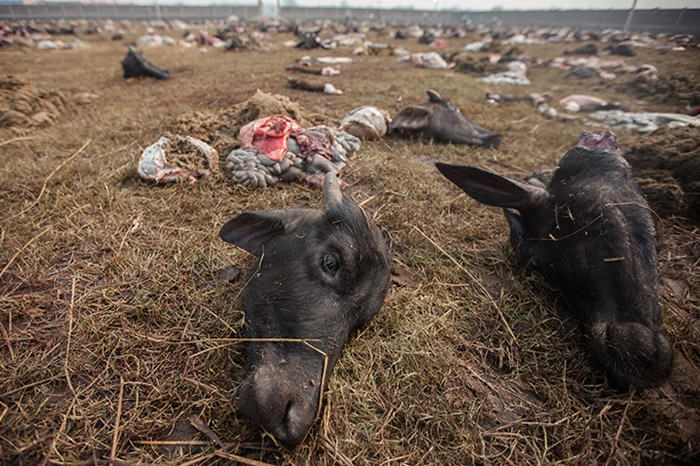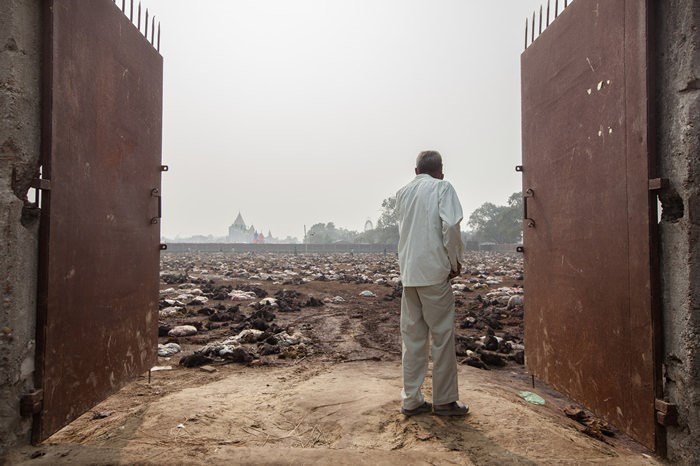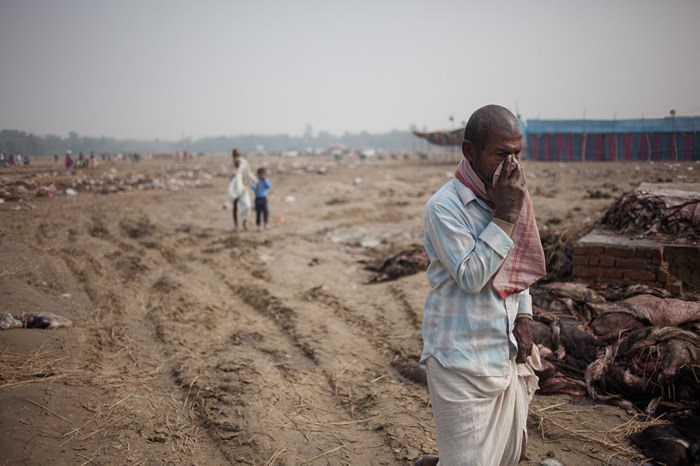Nepal’s Gadhimai Animal Slaughter Festival: Never Again
ANIMAL RIGHTS - VEGETARIANISM, 8 Dec 2014
Compassion in World Farming – TRANSCEND Media Service
Please note that this picture story contains graphic images of animal slaughter that may cause distress.
In the days before the festival, thousands of animals were walked or trucked to the festival site. Many came from India, and reports suggest thousands more were stopped at the border and turned back thanks to laws imposed by the Indian Government.
We saw people leading goats and small buffalo calves draped in red cloth or with red sashes round their necks signifying they are heading for sacrifice – at one point two calves had collapsed to the ground and were refusing to stand up.
Manoj Gautam from Animal Welfare Network Nepal (left) and Nanditha Krishna of Humane Society International (centre) made a last attempt to plead with the Head Priest of the Gadhimai Temple, Mr Chaudry.
The priest seemed to be listening to Manoj at one stage but apparently he had been pressurised by the Gadhimai Committee and it seemed his hands were tied.
This young goat hung his head as he was led to the festival for slaughter. Buffalo are the prize animal at the festival, but smaller animals including goats, chickens, pigs, pigeon and even mice are slaughtered.
The Gadhimai festival is not just about slaughter. It’s a huge festival with stalls, rides, and all manner of celebrations. Compassion Patron Joanna Lumley asked at our protest in London “why can’t we have the festival, but without the slaughter?” With the fairground rides behind them, two boys manoeuvre chickens that will later be slaughtered for the festival.
The main area where buffalo were slaughtered is surrounded by a 6-foot wall. Local police were attempting to enforce a ban on photography but our investigators managed to photograph a first glimpse through a small hole in the wall, revealing the buffalo beyond.
Slaughtering began on the morning of 28th November.
The slaughterers walked inside from the far gate, and the killing began. The crowds pressed towards the walls, people were shouting and blowing horns, bells were ringing, drums beating in the background.
It was clear that some men were more skilled at the job than others – it seemed like the objective was to remove the head in one cut, but we saw men taking several blows to finish the job, I can’t imagine the pain these animals must have suffered.
By halfway through, the buffalo were bellowing, and appeared completely confused. They lowered their heads to sniff the bodies of the dead. Some tried to run away from the approaching slaughterers or break loose from their ropes but were soon recaptured.
Unlike the buffalo, the goats were not sacrificed in any centralised area but our investigators saw many people carrying goats and other carcasses home from the festival.
By the start of the 29th November, most of the bodies had been removed from the site, leaving pools of blood and waste. Hundreds of buffalo heads with eyes open, gazing upwards, were scattered around.
The gates of the stadium stood open on day two of the slaughter. Buffalo were led in one-by-one to be beheaded among what was left of the carcasses.
One man emerged from the main stadium gate and vomited as we made our way in.
Slaughter of other animals continued throughout the vast area covered by the festival.
By the end of the festival, the whole area was absolutely stinking, people were covering their faces with fabric to try and mask it.
The suffering involved in this slaughter festival was immense. Thousands of animals ended their lives in fear and pain. But over the last months and years the vast international campaign that has been launched against this festival has ensured that this is the beginning of the end.
- The Nepalese Government did not give any official funds to the festival.
- The Indian Government took action at the country’s border and thousands of animals were prevented from crossing into Nepal for the festival.
- AWNN successfully convinced many festival goers to forgo sacrifice and instead make a small cut to their animal’s ear as an alternative blood-offering, saving the lives of over 300 buffalo.
- The number of animals involved was vastly reduced – we believe by at least 75% in comparison to the last festival in 2009.
- Due to the reduction in buffalo numbers a contract that had been agreed with a meat-buyer was cancelled, which is likely to have had a huge financial impact on the festival organisers.
- Despite rumoured government attempts to ban photography, the international press widely covered the festival, applying additional pressure on the Government to make sure this sacrifice never happens again.
Please, add your voice to this campaign and email the Nepalese Government demanding an end to the Gadhimai Festival and others like it in Nepal: Never Again.
DISCLAIMER: The statements, views and opinions expressed in pieces republished here are solely those of the authors and do not necessarily represent those of TMS. In accordance with title 17 U.S.C. section 107, this material is distributed without profit to those who have expressed a prior interest in receiving the included information for research and educational purposes. TMS has no affiliation whatsoever with the originator of this article nor is TMS endorsed or sponsored by the originator. “GO TO ORIGINAL” links are provided as a convenience to our readers and allow for verification of authenticity. However, as originating pages are often updated by their originating host sites, the versions posted may not match the versions our readers view when clicking the “GO TO ORIGINAL” links. This site contains copyrighted material the use of which has not always been specifically authorized by the copyright owner. We are making such material available in our efforts to advance understanding of environmental, political, human rights, economic, democracy, scientific, and social justice issues, etc. We believe this constitutes a ‘fair use’ of any such copyrighted material as provided for in section 107 of the US Copyright Law. In accordance with Title 17 U.S.C. Section 107, the material on this site is distributed without profit to those who have expressed a prior interest in receiving the included information for research and educational purposes. For more information go to: http://www.law.cornell.edu/uscode/17/107.shtml. If you wish to use copyrighted material from this site for purposes of your own that go beyond ‘fair use’, you must obtain permission from the copyright owner.
Read more
Click here to go to the current weekly digest or pick another article:
ANIMAL RIGHTS - VEGETARIANISM:
